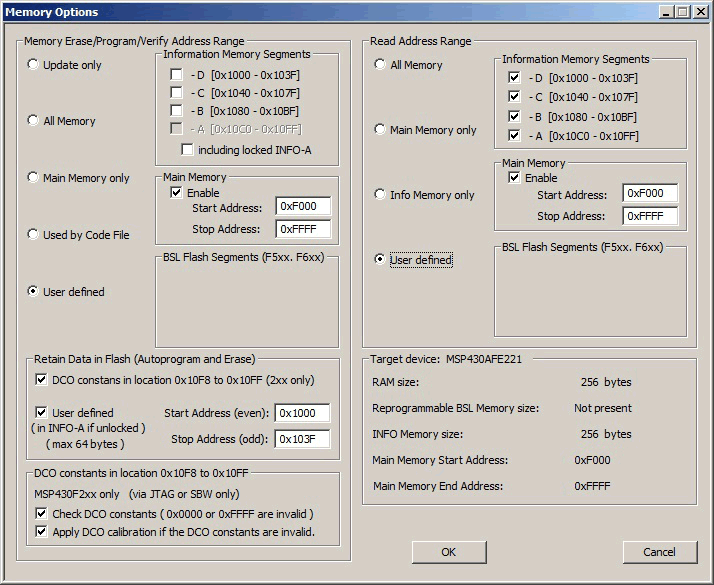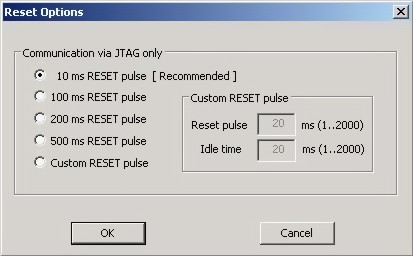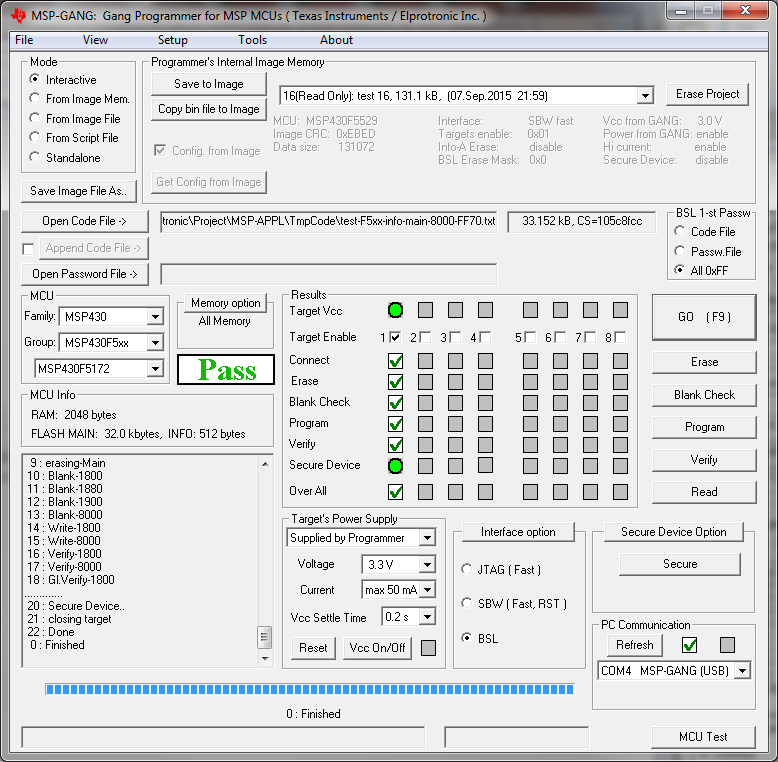SLAU358Q September 2011 – October 2019
- Read This First
- 1Introduction
-
2Operation
- 2.1
Programming MSP Flash Devices Using the MSP Gang Programmer
- 2.1.1 Programming Using Interactive Mode
- 2.1.2 Programming From Image
- 2.1.3 Programming From Script
- 2.1.4 Programming in Standalone Mode
- 2.1.5 Memory Setup for GO, Erase, Program, Verify, and Read
- 2.1.6 Secure Device Setup and Memory Protection
- 2.1.7 Programming MCU With IP Encapsulated Segment
- 2.1.8 Serialization
- 2.1.9 Creating and Using Images
- 2.1.10 Programming From Image File
- 2.1.11 Programming From SD Card
- 2.1.12 File Extensions
- 2.1.13 Checksum Calculation
- 2.1.14 Commands Combined With the Executable File
- 2.2 Data Viewers
- 2.3 Status Messages
- 2.4 Self Test
- 2.5 Label
- 2.6 Preferences
- 2.7 Benchmarks
- 2.1
Programming MSP Flash Devices Using the MSP Gang Programmer
-
3Firmware
- 3.1 Commands
- 3.2 Firmware Interface Protocol
- 3.3 Synchronization Sequence
- 3.4 Command Messages
- 3.5
Detailed Description of Commands
- 3.5.1 General
- 3.5.2
Commands Supported by the BOOT Loader
- 3.5.2.1 "Hello" Command
- 3.5.2.2 Boot Commands Disable
- 3.5.2.3 Boot Commands Enable
- 3.5.2.4 Get Diagnostic Command
- 3.5.2.5 Select Baud Rate Command
- 3.5.2.6 Erase Firmware Command
- 3.5.2.7 Load Firmware Command
- 3.5.2.8 Exit from Firmware Update Command
- 3.5.2.9 Get Label Command
- 3.5.2.10 Get Progress Status
- 3.5.3 Commands Supported by Application Firmware
- 3.5.4
API Firmware Commands That Should Not be Used
- 3.5.4.1 Interactive Process Command
- 3.5.4.2 Erase Image Command
- 3.5.4.3 Read Info Memory From MSP-GANG Command
- 3.5.4.4 Write to MSP-GANG Info Memory Command
- 3.5.4.5 Verify Access Key Command
- 3.5.4.6 Write to Image Block Command
- 3.5.4.7 Verify Image Check Sum Command
- 3.5.4.8 Read Image Header Command
- 3.5.4.9 Disable API Interrupts Command
- 3.5.4.10 Display Message on LCD Display Command
- 3.5.4.11 Set IO State Command
-
4Dynamic Link Library for MSP-GANG Programmer
- 4.1 Gang430.dll Wrapper Description
- 4.2
MSP-GANG.dll Description
- 4.2.1 MSPGANG_GetDataBuffers_ptr
- 4.2.2 MSPGANG_SetGangBuffer, MSPGANG_GetGangBuffer
- 4.2.3 MSPGANG_GetDevice
- 4.2.4 MSPGANG_LoadFirmware
- 4.2.5 MSPGANG_InitCom
- 4.2.6 MSPGANG_ReleaseCom
- 4.2.7 MSPGANG_GetErrorString
- 4.2.8 MSPGANG_SelectBaudrate
- 4.2.9 MSPGANG_GetDiagnostic
- 4.2.10 MSPGANG_MainProcess
- 4.2.11 MSPGANG_InteractiveProcess
- 4.2.12 MSPGANG_Interactive_Open_Target_Device
- 4.2.13 MSPGANG_Interactive_Close_Target_Device
- 4.2.14 MSPGANG_Interactive_DefReadTargets
- 4.2.15 MSPGANG_Interactive_ReadTargets
- 4.2.16 MSPGANG_Interactive_ReadBytes
- 4.2.17 MSPGANG_Interactive_WriteWord_to_RAM
- 4.2.18 MSPGANG_Interactive_WriteByte_to_RAM
- 4.2.19 MSPGANG_Interactive_WriteBytes_to_RAM
- 4.2.20 MSPGANG_Interactive_WriteBytes_to_FLASH
- 4.2.21 MSPGANG_Interactive_Copy_Gang_Buffer_to_RAM
- 4.2.22 MSPGANG_Interactive_Copy_Gang_Buffer_to_FLASH
- 4.2.23 MSPGANG_Interactive_EraseSectors
- 4.2.24 MSPGANG_Interactive_BlankCheck
- 4.2.25 MSPGANG_Interactive_DCO_Test
- 4.2.26 MSPGANG_SelectImage
- 4.2.27 MSPGANG_EraseImage
- 4.2.28 MSPGANG_CreateGangImage
- 4.2.29 MSPGANG_LoadImageBlock
- 4.2.30 MSPGANG_VerifyPSAImageBlock
- 4.2.31 MSPGANG_ReadImageBlock
- 4.2.32 MSPGANG_Read_Code_File
- 4.2.33 MSPGANG_Save_Config, MSPGANG_Load_Config, MSPGANG_Default_Config
- 4.2.34 MSPGANG_SetConfig, MSPGANG_GetConfig
- 4.2.35 MSPGANG_GetNameConfig, MSPGANG_SetNameConfig
- 4.2.36 MSPGANG_SetTmpGANG_Config
- 4.2.37 MSPGANG_GetLabel
- 4.2.38 MSPGANG_GetInfoMemory, MSPGANG_SetInfoMemory
- 4.2.39 MSPGANG_Get_qty_MCU_Type, MSPGANG_Set_MCU_Type, MSPGANG_Get_MCU_TypeName, MSPGANG_Get_qty_MCU_Family, MSPGANG_Get_MCU_FamilyName, MSPGANG_Get_MCU_Name
- 4.2.40 MSPGANG_Set_MCU_Name
- 4.2.41 MSPGANG_HW_devices
- 4.2.42 MSPGANG_GetProgressStatus
- 4.2.43 MSPGANG_GetAPIStatus
- 4.2.44 MSPGANG_Set_IO_State
- 4.2.45 MSPGANG_Convert_Address
- 4.2.46 MSPGANG_Memory_Header_text
- 4.2.47 MSPGANG_Interactive_ClrLockedDevice
- 4.2.48 MSPGANG_Get_Code_Info
- 4.2.49 MSPGANG_MakeSound
- 4.2.50 MSPGANG_CallBack_ProgressBar
- 4.2.51 MSPGANG_GetPCHardwareFingerprint
- 4.2.52 MSPGANG_Flash_valid_addr
- 5Schematics
-
6Frequently Asked Questions
- 6.1 Question: Why does device init, connect, or programming fail?
- 6.2 Question: Can I use single wires for connection between MSP-GANG and target device?
- 6.3 Question: How to serialize parts?
- 6.4 Question: How to have parts run after programming?
- 6.5 Question: What are possible reasons for the part to fail Verify step?
- Revision History
2.1.1 Programming Using Interactive Mode
Use the following sequence to start the MSP Gang Programmer GUI and program MSP Flash Devices using the Interactive Mode:
- Click on the MSP Gang Programmer icon located in the program group that was specified during installation. Figure 2-1 shows the MSP Gang Programmer GUI in the Interactive Mode (see the Mode group in the top left corner). This window is used to select the target microcontroller, code file used for programming, power supply options, communication interface, and more. This window also shows the result of programming and any errors, if they occur.
- Select a target device using the MCU Family, then MCU Group, and then desired MCU Type.
- Select the code file to be programmed into the devices using the Open Code File button or pulldown menu: File→Open Code File. The formats supported for the code file are TI (.txt) and Intel (.hex) and Motorola (.s19, .s28, .s37). Code size and checksum appear on the right side (for details on how the checksum is calculated, see Section 2.1.13).
- Optionally add another code file to be programmed into the devices using the Append Code File button (check the box on the left to enable this option). This feature is useful for updating BSL firmware in 5xx or 6xx MCUs. The two code files are combined together to create one final code file. If a conflict is detected, a warning appears; however, if programming proceeds without changes the second code file overwrites the conflict area. Code size and checksum appear on the right side.
- Some MCUs (for example, the MSP430FR57xx) provide a method of disabling JTAG by programming a password to flash memory. The password should be specified as data to be programmed starting at 0xFF80 and up to 0xFFFF (where 0xFF80 must be 0xAAAA, 0xFF82 must be the size of the password in words, and 0xFF88-0xFFFF contains the password). The code file must contain password contents if you intend to lock JTAG using the password feature after programming. If the MCU is already locked using a previously programmed code file, then you must provide the password section (or entire old code file) using the Open Password File button if and only if the password section is different. Functionally, if the MCU is locked by password, the code file’s password section is first used to attempt to unlock the MCU. If that fails, then the password file’s contents are used to attempt to unlock the MCU. If both attempts fail, the MCU remains locked and JTAG access fails. Password file contents are not used to program the MCU.
- In the Target power group, select the desired VCC voltage and select if the target is supplied from the MSP Gang Programmer or from an external power supply. If targets are supplied by the programmer, then select the maximum current used by each target, 30 mA or 50 mA.
- In the Results group, select desired target devices to be programmed. After programming has concluded, a green checkmark or lights appear for successful operations for each target.
- In the Interface selector, choose the desired interface (JTAG, SBW, SWD, or BSL) and communication speed (fast, medium, or slow).
- In the Memory Options dialog (pulldown menu: Setup→Memory options ) shown in Figure 2-2, select desired memory space to be programmed. By default, the selected option is All Memory and it is correct for most programming tasks (Section 2.1.5 describes how to use the memory configuration window).
- In the Reset Options dialog (pulldown menu: Setup→Device Reset ) shown in Figure 2-3, select the duration of the reset pulse and the delay after reset. By default it is 10 ms, but other options are available if required by the hardware.

A. The user can select which segments of memory are written to or read from.
Figure 2-2 Memory Options 
A. This window lets the user specify the duration of the reset pulse coming from the MSP Gang Programmer to the target device. Depending on the hardware implementation, a longer reset pulse might be required.
Figure 2-3 Reset Options Following these steps creates a working setup that can program target devices using the MSP Gang Programmer. Click the Save Project As button to save this configuration settings. These settings can be loaded again later and modified, if necessary (one project holds one configuration). After saving the project, use the buttons described in the following sections to perform the desired actions.
